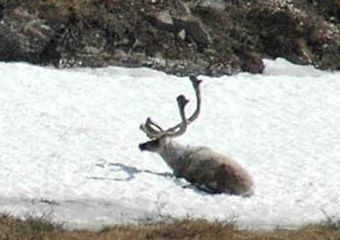The NatureServe Climate Change Vulnerability Index identifies plant and animal species that are particularly vulnerable to the effects of climate change. Using the Index, you apply readily available information about a species’ natural history, distribution and landscape circumstances to predict whether it will likely suffer a range contraction and/or population reduction due to climate change. You can use the Index as part of a variety of analyses, including assessing the relative risk of species listed in conservation plans or part of any assessment of the vulnerability of species to climate change.
The Canadian version of the NatureServe Climate Change Vulnerability Index is tailored for use in Canadian assessment areas.

Land-management and natural-resource professionals are increasingly asked to identify which of the plants and animals that inhabit the lands and waters they manage are most vulnerable to the impacts of climate change. But the factors that influence the exposure and response of any given species are numerous, making assessments in this complex and rapidly emerging field of study difficult.
The NatureServe Climate Change Vulnerability Index translates research findings into useful guidelines that enable practitioners and policy-makers to identify emerging and anticipated threats to biodiversity. The tool also supports regional approaches and broader contexts thanks to its reliance on standardized data that extends across provincial boundaries. By enabling those responsible for managing lands to assess species’ relative vulnerability—as well as the relative importance of factors contributing to such assessments—the Index can help prioritize management strategies for climate change adaptation and develop actions that increase the resilience of species to climate change.
The Climate Change Vulnerability Index provides a rapid, cost-effective means of estimating a plant or animal species’ relative vulnerability to climate change. It combines readily accessible information on the natural history, distribution, and management with downscaled climate predictions. The Index can be used for both rare and common plants and animals—an important factor given that overall conservation status has proven to be an unreliable proxy for vulnerability to climate change.
The Index separates vulnerability into its three primary components: a species’ exposure to climate change within a particular assessment area, its inherent sensitivity to climate change, and its capacity to adapt to change. The tool gauges 24 scientifically documented factors and indicators of these components, as well as documented responses to climate change where they exist. While the Index calculates the likelihood of declines in populations of individual species, it also accommodates inherent uncertainties about how species respond within their ecological contexts.
Results fall into five categories:
- Extremely Vulnerable
- Highly Vulnerable
- Moderately Vulnerable
- Less Vulnerable
- Insufficient Evidence
Resource managers, planners, and conservationists can use the Index to:
- Conduct rapid assessments of the relative vulnerability of both rare and common species to climate change
- Identify the most critical risk factors for groups of species
- Highlight target species that warrant more in-depth study and research
- Detect areas containing high concentrations of species threatened by climate change impacts
- Begin to examine how impacts may cause the range of species populations to expand or retreat
- Complement conservation status assessments to set conservation priorities across property and jurisdictional boundaries
- Promote coordination, consistency, and efficiency of planning and managing for adaptation
- Provide valuable input on species in key planning documents such as State Wildlife Action Plans
About Version 3.0
Every day, we learn more about our climate, the changes it is undergoing, and the impacts of those changes on biodiversity. NatureServe actively incorporates that new knowledge into our databases, tools, and services. Completed in December 2015, version 3.0 of the NatureServe Climate Change Vulnerability Index - Canadian Version reflects these advances in our understanding of how climate change affects plants and animals.
- Download the Guidelines for Using the NatureServe Climate Change Vulnerability Index - Canadian Version v3.0. This document outlines the rationale for the Index, describes how it works, provides step-by-step instructions for applying the criteria used, and lists ways you can apply the results in strategies for adaptation planning.
- Download the NatureServe Climate Change Vulnerability Index tool (version 3.01; 11MB). The Index itself is an Excel 2007 workbook that allows you to apply it to individual plant and animal species and store the results. You should consult the Guidelines for instructions on proper use of the Index, and please contact NatureServe for additional instruction before embarking on projects that make extensive use of the tool, to ensure proper interpretation and application.
Useful Climate Data
The Climate Change Vulnerability Index - Canadian Version requires data on projections for changes in temperature and climate moisture deficit. To obtain these data, contact us.
Previous Version of the Climate Change Vulnerability Index
Release 2.01